views
Mastering the Basics
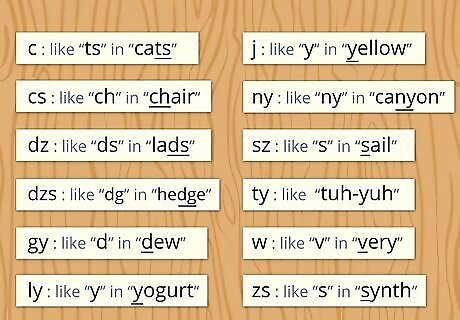
Practice the Hungarian alphabet. The Hungarian alphabet uses Latin characters but consists of 44 letters. Many of these, such as b, d, g, h, k, l, m, n, p, r, t, v, and z, will be familiar to English speakers. Other sounds will take some time to master, including: C, pronounced ts as in “cats” Cs, pronounced ch as in “chair” Dz, pronounced ds as in “lads” Dzs, pronounced dg as in “hedge” Gy, pronounced d as in “dew” but is made by pushing the sound through the roof of mouth and tongue Ly, pronounced y as in “yogurt” J, pronounced y as in “yellow” Ny, pronounced as it sounds in “canyon” Sz, pronounced s as in “sail” Ty, pronounced t as in “tudor” W, pronounced v as in “very” Zs, pronounced su as in “casual”
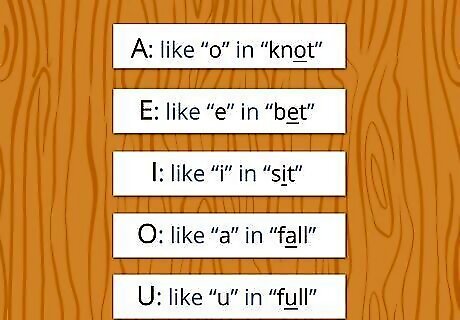
Differentiate vowel sounds by accent marks. There are at least 2 forms of each Hungarian vowel, one without an accent and one with an acute accent. In addition to the unaccented and acute forms, O and U also have 2 additional forms, one with umlaut and one with diaeresis. The Hungarian vowels are: A, pronounced like ‘u’ in “umbrella” Á, pronounced like ‘a’ in “sparse” E, pronounced like ‘e’ in “bet” É, pronounced like ‘ai’ in “sail” I, pronounced like ‘i’ in “sit” Í, pronounced like ‘ee’ in “feet” O, pronounced like ‘a’ in “top” Ó, pronounced like ‘aw’ in “law” Ö, pronounced like ‘e’ in “under” Ő, pronounced as 'ö' but held longer” U, pronounced like 'u’ in “put” Ú, pronounced like ‘oo’ in “spoon” Ü, pronounced like ‘u’ in “menu” Ű, pronounced like ‘u’ in “uber”
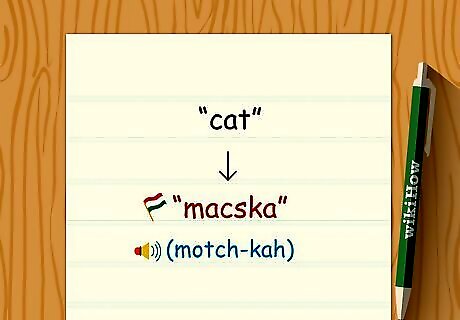
Pronounce Hungarian words phonetically. Once you’ve mastered the Hungarian alphabet, pronunciations are actually rather easy. Hungarian is an entirely phonetic language, meaning words are pronounced exactly as they are spelled. There are no diphthongs or digraphs. Also, vowels don’t change based on the letters next to them like they do in English. For example, the word “kutya,” meaning “dog” is pronounced “kuh-t-yah.” The spelling directly indicates the pronunciation. Likewise, “macska,” meaning “cat,” is pronounced “mutch-kah,” directly following the pronunciation rules of the Hungarian alphabet.
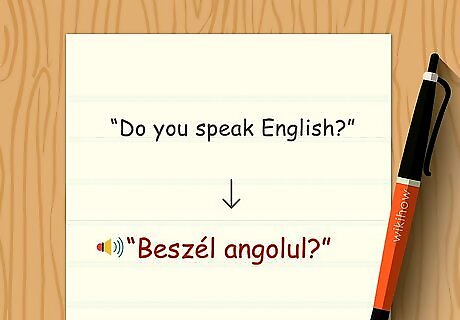
Learn a few useful phrases. Before you jump into the complex grammar of Hungarian, try reading a few basic phrases. Use these as a chance to practice reading the Hungarian alphabet and to kick-start your Hungarian conversational skills. Try phrases like: "Helló,” meaning “hello.” "Hogy vagy?” meaning “How are you?” (informal) "Szép napot!” meaning “Have a nice day.” "Igen” meaning “yes.” "Nem” meaning “no.” "Beszél angolul?” meaning “Do you speak English?” "Beszél magyarul?” meaning “Do you speak Hungarian?” "Kérem” meaning “please.” " Köszönöm” meaning “thank you.” "Elnézést” meaning “excuse me.”
Tackling Basic Grammar
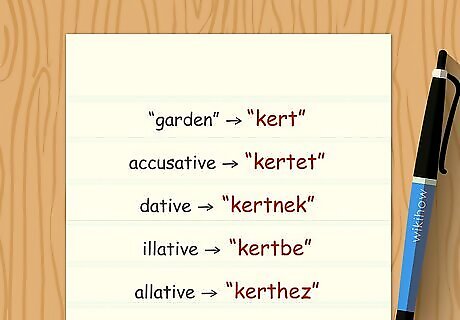
Study the different cases in Hungarian. Hungarian has 35 distinct cases, or declensions, all of which are added on as suffixes to a base word. This means that Hungarian does not rely on prepositions like "in," "on," "from," and "with." Instead, the case can be found after the base word. Take the word “kert,” meaning “garden,” for example: In the accusative form, when it is used as an object, it is “kertet” singular or “kerteket” plural In the dative form, indicating "for" or "of," it is “kertnek” singular or “kerteknek” plural In the Illative form, indicating "into," it is “kertbe” singular or “kertekbe” plural In the allative form, indicating "to" or "toward," it is “kerthez” singular or “kertekhez” plural
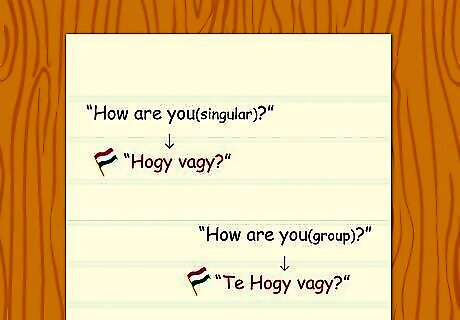
Use subject pronouns for emphasis. Since you can build very long words in Hungarian that convey a lot of information, you don’t need all the same parts of speech that you see in other languages. This includes pronouns. Pronouns can be seen in the conjugation of the word, so you only use a subject pronoun when you want to emphasize something. Otherwise, the pronoun should be omitted. Look at the pronoun “te” meaning “you.” If you’re directly asking someone “How are you?” you don’t need the pronoun, so you would ask “Hogy vagy?” without adding “te.” However, if you were speaking to someone in a group and want to ask that one person in particular how they are doing, you would add the “te” to make the sentence “Te hogy vagy?”
Create vowel harmony between bases and suffixes. The vowels in the suffixes you add onto a word need to match the vowels in the base word. Take the suffix “-ban,” which means “in the.” To communicate that something is in the house, you would add “-ban” to the base word “ház” (house) to make “házban.” However, you couldn’t use “-ban” for “kert,” because that doesn’t create a consistent vowel sound. Instead, to indicate “in the garden” you would add “-ben” to make “kertben.” Vowel harmony depends on whether the word is a front vowel word or back vowel word. For words where the high point of your tongue is toward the front of your mouth, use the front vowel case. For words where the high point of your tongue is toward the back of your mouth, use the back vowel case.

Place words at the start of a sentence to emphasize them. Hungarian doesn’t have a word order convention like English, which typically goes subject-verb-object. You can be creative with your word orders in Hungarian. If you want to emphasize a word, though, it should go at the start of the sentence before any conjugated verbs. Take the sentence “Hedvig látja Alexet,” meaning “Hedvig sees Alex.” "Hedvig látja Alexet” means that Hedvig sees Alex. Hedvig is the focus of the sentence, not Alex. "Alexet látja Hedvig” puts the focus on Alex. This means it’s Alex, and not another person, that Hedvig sees. "Látja Hedvig Alexet” emphasizes the verb, meaning Hedvig sees Alex, as opposed to, for example, hearing him. The suffix on Alex's name indicates that he is the object in the sentence, even though his name may come before Hedvig's. To say "Alex sees Hedvig," you would say, "Alex látja Hedviget," "Hedviget látja Alex," or "Látja Alex Hedviget," depending on what you want to emphasize.

Put negatives and questions before verbs. Negative words like "not" and "don’t" and words to indicate questions like "who," "what," or "how," always come before a conjugated verb. You can reorder emphasized words, but both emphasized words and question and negative words should come before verbs. "Kit lát Hedvig?” for example, means “Whom does Hedvig see?” “Hedvig kit lát?” means the same thing, but it emphasizes Hedvig. The sentence then means “Whom does Hedvig see?” "Nem látom Hedviget,” likewise, means “I don’t see Hedvig.” “Nem Hedviget látom” means “It’s not Hedvig I see.”

Memorize the basic verb tenses. Hungarian only has 3 verb tenses – one past, one present, and one future. There is no distinction in conjugation between sentences like, “He ran,” and “He would have run,” because those differences are communicated in other ways throughout the sentence. The verb conjugations change depending on the vowels in the verbs since conjugations need to follow the rule of verb harmony. Since there are many possible verb endings, it helps to get a Hungarian language book to help you memorize different verb endings.
Studying Hungarian Effectively

Enroll in a language-learning class. Since Hungarian is a language isolate with unique grammatical rules and sentence structures, it can be difficult for non-native speakers to pick up. Enrolling in a formal course can help you better understand the rules and nuances of the language. Ideally, look for one where you can speak directly with an instructor either in-person or online. Take a look at your local community college or university extension program. These often offer a variety of language courses for reasonable prices. There are a number of affordable Hungarian language courses available online. You can also check online for Hungarian language tutors. If there are none in your immediate area, look for a tutor willing to do online sessions with a webcam and microphone.

Join a conversation group or forum. Practicing writing and speaking Hungarian is just as important as memorizing the rules of the language. Look on sites like Duolingo, Meetup, and Conversation Exchange to meet up and practice speaking with other people in your area learning Hungarian. You can also look for online meetups that allow you to chat with groups or native speakers using your webcam. Additionally, language forums are great places to practice writing in Hungarian and get input from other students of the language. Don’t be afraid to make mistakes. They can help reinforce concepts that you weren’t getting before. Plus, other learners are usually forgiving since they’ve made their share of mistakes, too.

Practice Hungarian every day. Designate a block of time each day to learn new Hungarian and to practice what you’ve already learned. If you can, try to set aside 30 minutes to an hour. If you don’t have that much time, even 5-15 minutes helps reinforce what you’ve learned. Apps like Mango and Duolingo can help you practice Hungarian during your coffee break, lunch break, or commute.

Read articles and lists in Hungarian. Once you’ve become familiar with basic Hungarian, search online for contemporary news and popular culture content. Even if you have to look things up or take extra time reading, this helps you build your understanding of the Hungarian language. News articles and content like listicles are generally written to an elementary language understanding and can be great sources for idioms, jokes, and slang.

Travel to Hungary if you have the means. Immersion is the best way to learn almost any new language. If you have the ability, head to Hungary to try out your language skills and pick up tips from the locals. If you’re still in school, consider taking a semester abroad in Hungary. If you have less time, look for a 1 or 2-week language immersion tour in Hungary, which you can find through many travel companies.

Immerse yourself in Hungarian-language media. If you don’t have the time or finances to travel to Hungary, you can still immerse yourself in the language by watching shows in Hungarian and participating in online chats with native speakers. Practice your listening skills by listening to Hungarian radio online at http://www.dunamsz.hu/radio/?lang=hu_hu. Check out Hungarian news programming and contemporary culture by watching the Hungarian national broadcasting organization, Magyar Televízió, at http://www.mtva.hu/. Read the poems of Endre Ady and Alice Lok Cahana and read the stories of Péter Nádas and Imre Kertész to get a sense of Hungarian literary culture.



















Comments
0 comment